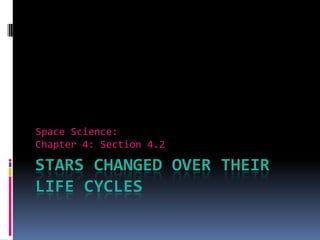4.2 Stars have Life Cycles
- 1. Stars changed over their life cyclesSpace Science:Chapter 4: Section 4.2
- 2. Let’s BeginWhy do stars look like small points of light?Why don’t they look like in the sky?Stars are very far away.We only see a few thousand of stars that exist.
- 3. What unit of measurement do we use to measure the distance between stars?Light-yearsThe distance light travels in one yearApproximately 6 trillion milesThe closest star to Earth is our SunThe next closest star is 4 light years away
- 4. How do we measure how far stars are away from Earth?Using parallaxThe apparent shift in the position of an object when viewed from different locationsParallax Demonstrations
- 5. Size: the Sun’s diameter is 100x greater than Earth’s
- 6. Some stars are much larger than the Sun. Giant and Super giants are 10-100’s of times larger.
- 7. Betelgeuse: 600 times greater than the Sun
- 8. There are stars much smaller than the Sun as well. These are called white dwarfs.
- 9. What color are the stars we see?Most stars are whiteSome appear redSome appear blueWhy is that?Differences in color are due to differences in temperature
- 10. Think of:The metal coils inside of a toasterStart off as a dull redLater turn a bright orangeTemperature affects color by heating up the metal
- 11. Stars have life cycles:Length of the cycle and the way a star changes depends on the mass of the star
- 12. Nebula:All stars form inside a cloud of gas and dust called a nebulaGravity pulls the dust closer togetherThe matter contracts and forms a hot dense sphere
- 13. Main Sequence:Fusion begins if the matter gains enough temperature and densityThe birth of main sequencestars
- 14. Low-Mass Stars:Once fusion begins the star is then classified as a main sequence starLow-mass stars use their fuel slowlyRemain in this stage for billions of yearsAs low-mass stars run out of fuel it expands into a giant starOnce the giant sheds it outer layer it leaves behind a dead core called a white dwarf
- 16. High-Mass Stars:Once fusion begins the star is then classified as a main sequence starHigh-mass stars use their fuel quicklyRemain in this stage for millions of yearsAs high- mass stars run out of fuel it expands into a super giant The super giant explodes when no more fusion can occur- called a supernova
- 18. High-Mass Stars: After supernovaMay form a dense body called a neutron starStar squeezes itself smallerVery DENSE- Example: pea size sample weighs 100 million tonsGravitational force collapses atomsElectrons combined with protons to produce neutronsMay form a black holeMore dense than neutron starIntense surface gravity lets no light escapeAs matter is pulled into the black hole it becomes very hot and emits x-rays
- 20. The Sun is what type of star?Low-MassMain Sequence StarWhat is going to happen to the Sun?Eventually expand into a Red GiantCool down into a white dwarfScientist predict that in 4.5 billions years the Sun will run out of fuel and will form a Red Giant

